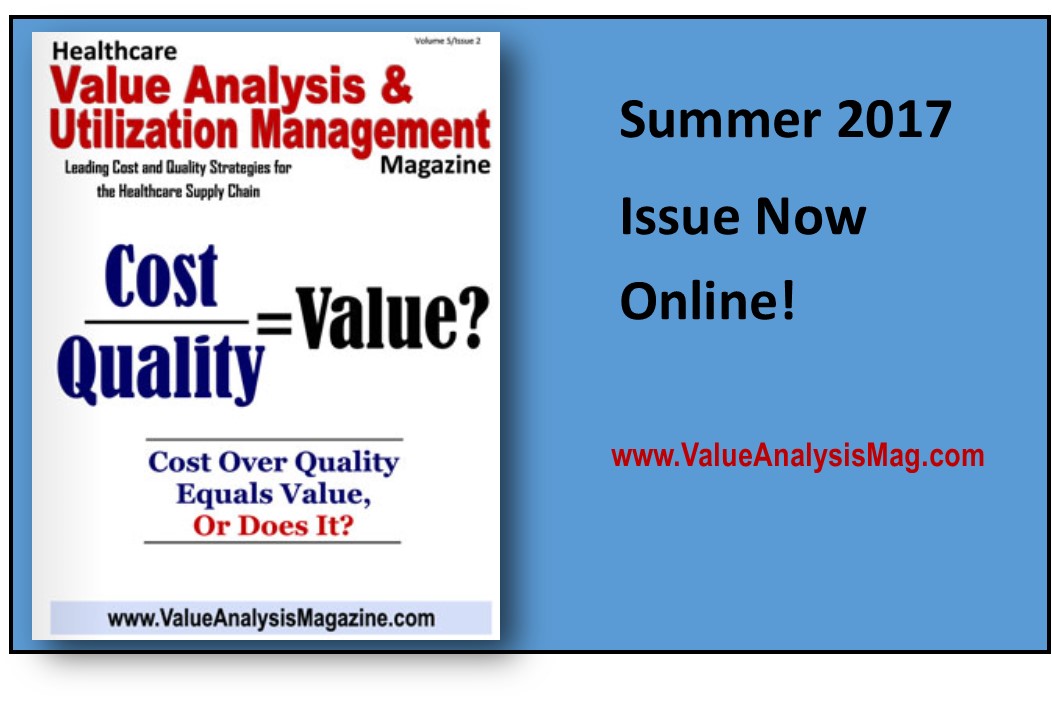Robert W. Yokl, Senior Vice President/COO, SVAH Solutions
Historically, surgical value analysis (SVA) teams focused on evaluating the newest technologies that surgeons and clinical leaders believed would improve patient outcomes for their respective procedures/cases. While this remains a stalwart goal of most SVA teams, we must evolve to meet the growing challenges our hospitals, systems, and IDNs face. The primary question that remains is, how and where do we need to progress our SVA teams? I thought it would be great to not only share my views on this important topic, but I have reached out to my colleagues at the Association of Value Analysis Professionals who are distinguished value analysis leaders and experts to get their take on new SVA best practices.
Barbara Strain, Director of Value Management- University of Virginia Health: With the Affordable Care Act taking full effect on our industry, we must start to work towards surgical value analysis aligning with the oncoming value based purchasing initiatives. For example, there are test initiatives for a bundled payment model starting with comprehensive joint replacement (CJR) that the hospital will be responsible for a patient from the time of diagnosis to the joint replacement and for 90 days through recovery. The hospital is accountable for the outcome of the patient through the entire continuum of their joint replacement regardless of whether the patient has a positive or negative result with an owned or not owned entity of the hospital. This could dramatically affect the way the hospital is reimbursed and may bring on competition from other value based purchasing groups in and out of their region for the business of performing the total joint procedure.
At the University of Virginia, SVA teams focus on tracking the cost and variation of procedures to educate all involved whether it be the surgeons, clinical or non-clinical support team, or even an outside vendor. Our goals are to identify the variation in our surgical procedures in our controllable areas that will lead to improved quality outcomes. This will not only ensure reimbursement but will also lead to reduction of costs up to 20% by procedure type. The quality outcomes and cost savings may not be related to just supplies. It could also be procedural, support centric, or even as simple as changing the way electronic paperwork is submitted.
Gloria Graham, DNP, RN, CVAHP, Clinical Materials Specialist, Cincinnati Children’s Hospital – AHVAP President: At Cincinnati Children’s Hospital, we focus a lot of our attention on evidenced-based research to support our value analysis process including our surgical value analysis teams. The goal is not only to find just any evidence but to find evidence that is usable and can be communicated to our key surgeons, surgical leaders, and surgical support team. More importantly, we focus our attention on helping our nurses and clinicians understand how this evidence relates to our surgical value analysis processes. During my recent doctoral research work, I have found that this education process for surgeons and nurses is irreplaceable and should not be taken for granted. The research literature demonstrated that clinicians have a knowledge deficit regarding the value analysis process within the healthcare setting. There is no school of value analysis for the supporting players in our hospitals, systems, and IDNs. As SVA leaders, we need to start thinking about how to educate these key professionals in the next level of surgical value analysis.
Wanda Dupree-Lane, RN, MaED, CVAHP, Value Analysis Manager – Regional One Health: Forward thinking medical schools now include fiscal responsibility, quality and outcomes goals, and supply chain metrics in their curriculums, raising physician awareness of the cost of the business of healthcare. The benefit for SVA teams will be physicians who are open to change, understand variation reports, and share innovative ideas to reduce waste and costs. The challenge will be for those professionals who have been in healthcare for many years. For example, a surgical nurse who has worked in the OR for 18 years typically places cost, waste, and performance secondary to the procedure, the surgeon’s wants, and the quality of patient care. Challenging them to place patient care as highest priority, while considering cost, waste, and performance along with managing surgeons’ requests will require new ways of thinking and much support, as experienced professionals are thrust into increasingly hostile environments.
SVA teams should strategically recruit from this vast array of experienced professionals and integrate fresh faces with new ideas. A staffer new to surgical value analysis can be overwhelmed. At Regional One Health, we have a strategic team-building process that includes value analysis education for professionals all along the spectrum, from the novice to the experienced team leader. Inclusion, transparency, and safe communication environments are essential for team growth and success.
 One of the most important areas that I focus on with my clients is to establish baseline standards in the form of tracking supply utilization. For every product, procedure, or study, you have a before, during, and after happening with the products utilized. For example, if we are to evaluate a new instrument for use on laparoscopic surgery cases, more than likely there is a product that is already providing that function for the current cases. This product has a performance trend in the cost continuum that we need to tap into to ascertain the level of utilization of the new product during the implementation and thereafter. This way we ensure that we get the results that are expected from our value analysis studies. Plus, if supply utilization increases or decreases dramatically, it can be used as a red flag for good and/or bad quality over the short or long term.
One of the most important areas that I focus on with my clients is to establish baseline standards in the form of tracking supply utilization. For every product, procedure, or study, you have a before, during, and after happening with the products utilized. For example, if we are to evaluate a new instrument for use on laparoscopic surgery cases, more than likely there is a product that is already providing that function for the current cases. This product has a performance trend in the cost continuum that we need to tap into to ascertain the level of utilization of the new product during the implementation and thereafter. This way we ensure that we get the results that are expected from our value analysis studies. Plus, if supply utilization increases or decreases dramatically, it can be used as a red flag for good and/or bad quality over the short or long term.
To conclude, it’s time to look beyond how hospitals have employed surgical value analysis teams to work through new products and technologies. Unfortunately, for years, the majority of these teams only focused on new products and technologies. The world beyond new products and technologies is a road less traveled for many SVA teams. The good news is that inevitable evolution is happening at many organizations and value analysis teams should be thinking about incorporating the latest strategies and best practices. This forward-thinking step will give your teams a crucial advantage in the ever-important world of surgical value analysis.





